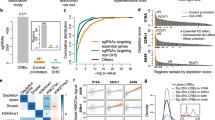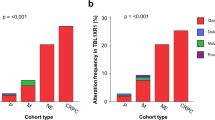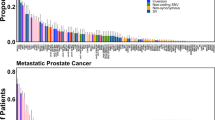Abstract
Genetic alterations associated with prostate cancer (PCa) may be identified by sequencing metastatic tumour genomes to identify molecular markers at this lethal stage of disease. Previously, we characterized somatic alterations in metastatic tumours in the methylcytosine dioxygenase ten-eleven translocation 2 (TET2), which is altered in 5–15% of myeloid, kidney, colon and PCas. Genome-wide association studies previously identified non-coding risk variants associated with PCa and melanoma. We perform fine-mapping of PCa risk across TET2 using genotypes from the PEGASUS case-control cohort and identify six new risk variants in introns 1 and 2. Oligonucleotides containing two risk variants are bound by the transcription factor octamer-binding protein 1 (Oct1/POU2F1) and TET2 and Oct1 expression are positively correlated in prostate tumours. TET2 is expressed in normal prostate tissue and reduced in a subset of tumours from the Cancer Genome Atlas (TCGA). Small interfering RNA-mediated TET2 knockdown (KD) increases LNCaP cell proliferation, migration and wound healing, verifying loss drives a cancer phenotype. Endogenous TET2 bound the androgen receptor (AR) and AR-coactivator proteins in LNCaP cell extracts, and TET2 KD increases prostate-specific antigen (KLK3/PSA) expression. Published data reveal TET2 binding sites and hydroxymethylcytosine proximal to KLK3. A gene co-expression network identified using TCGA prostate tumour RNA-sequencing identifies co-regulated cancer genes associated with 2-oxoglutarate (2-OG) and succinate metabolism, including TET2, lysine demethylase (KDM) KDM6A, BRCA1-associated BAP1, and citric acid cycle enzymes IDH1/2, SDHA/B, and FH. The co-expression signature is conserved across 31 TCGA cancers suggesting a putative role for TET2 as an energy sensor (of 2-OG) that modifies aspects of androgen-AR signalling. Decreased TET2 mRNA expression in TCGA PCa tumours is strongly associated with reduced patient survival, indicating reduced expression in tumours may be an informative biomarker of disease progression and perhaps metastatic disease.
This is a preview of subscription content, access via your institution
Access options
Subscribe to this journal
Receive 50 print issues and online access
$259.00 per year
only $5.18 per issue
Buy this article
- Purchase on Springer Link
- Instant access to full article PDF
Prices may be subject to local taxes which are calculated during checkout






Similar content being viewed by others
References
Jemal A, Bray F, Center MM, Ferlay J, Ward E, Forman D . Global cancer statistics. CA Cancer J Clin 2011; 61: 69–90.
Delhommeau F, Dupont S, Della V, James C, Trannoy S, Masse A et al. Mutation in TET2 in myeloid cancers. N Engl J Med 2009; 360: 2289–2301.
Saint-Martin C, Leroy G, Delhommeau F, Panelatti G, Dupont S, James C et al. Analysis of the ten-eleven translocation 2 TET2 gene in familial myeloproliferative neoplasms. Blood 2009; 114: 1628–1632.
Seshagiri S, Stawiski EW, Durinck S, Modrusan Z, Storm EE, Conboy CB et al. Recurrent R-spondin fusions in colon cancer. Nature 2012; 488: 660–664.
Sato Y, Yoshizato T, Shiraishi Y, Maekawa S, Okuno Y, Kamura T et al. Integrated molecular analysis of clear-cell renal cell carcinoma. Nat Genet 2013; 45: 860–867.
Brennan CW, Verhaak RG, McKenna A, Campos B, Noushmehr H, Salama SR et al. The somatic genomic landscape of glioblastoma. Cell 2013; 155: 462–477.
Setiawan VW, Schumacher F, Prescott J, Haessler J, Malinowski J, Wentzensen N et al. Cross-cancer pleiotropic analysis of endometrial cancer. Carcinogenesis 2014; 35: 2068–2073.
Song F, Amos CI, Lee JE, Lian CG, Fang S, Liu H et al. Identification of a melanoma susceptibility locus and somatic mutation in TET2. Carcinogenesis 2014; 35: 2097–2101.
Taylor BS, Schultz N, Hieronymus H, Gopalan A, Xiao Y, Carver BS et al. Integrative genomic profiling of human prostate cancer. Cancer Cell 2010; 18: 11–22.
Grasso CS, Wu YM, Robinson DR, Cao X, Dhanasekaran SM, Khan AP et al. The mutational landscape of lethal castration-resistant prostate cancer. Nature 2012; 487: 239–243.
Nickerson ML, Im KM, Misner KJ, Tan W, Lou H, Gold B et al. Somatic alterations contributing to metastasis of a castration-resistant prostate cancer. Hum Mutat 2013; 34: 1231–1241.
Eeles RA, Kote-Jarai Z, Al Olama AA, Giles GG, Guy M, Severi G et al. Identification of seven new prostate cancer susceptibility loci through a genome-wide association study. Nat Genet 2009; 41: 1116–1121.
Pomerantz MM, Werner L, Xie W, Regan MM, Lee GS, Sun T et al. Association of prostate cancer risk loci with disease aggressiveness and prostate cancer-specific mortality. Cancer Prev Res 2011; 4: 719–728.
Tonin P, Weber B, Offit K, Couch F, Rebbeck TR, Neuhausen S et al. Frequency of recurrent BRCA1 and BRCA2 mutations in Ashkenazi Jewish breast cancer families. Nat Med 1996; 2: 1179–1183.
Tomlins SA, Rhodes DR, Perner S, Dhanasekaran SM, Mehra R, Sun XW et al. Recurrent fusion of TMPRSS2 and ETS transcription factor genes in prostate cancer. Science 2005; 310: 644–648.
Varela I, Tarpey P, Raine K, Huang D, Ong C-K, Stephens P et al. Exome sequencing identifies frequent mutation of the SWI/SNF complex gene PBRM1 in renal carcinoma. Nature 2011; 469: 539–542.
Pena-Llopis S, Christie A, Xie XJ, Brugarolas J . Cooperation and antagonism among cancer genes. Cancer Res 2013; 73: 4173–4179.
Liu W, Laitinen S, Khan S, Vihinen M, Kowalski J, Yu G et al. Copy number analysis indicates monoclonal origin of lethal metastatic prostate cancer. Nat Med 2009; 15: 559–565.
Segil N, Roberts SB, Heintz N . Mitotic phosphorylation of the Oct-1 homeodomain and regulation of Oct-1 DNA binding activity. Science 1991; 254: 1814–1816.
Obinata D, Takayama K, Urano T, Murata T, Kumagai J, Fujimura T et al. Oct1 regulates cell growth of LNCaP cells and is a prognostic factor for prostate cancer. Int J Cancer 2012; 130: 1021–1028.
Barbieri CE, Baca SC, Lawrence MS, Demichelis F, Blattner M, Theurillat JP et al. Exome sequencing identifies recurrent SPOP FOXA1 and MED12 mutations in prostate cancer. Nat Genet 2012; 44: 685–689.
Baca SC, Prandi D, Lawrence MS, Mosquera JM, Romanel A, Drier Y et al. Punctuated evolution of prostate cancer genomes. Cell 2013; 153: 666–677.
Gao J, Aksoy BA, Dogrusoz U, Dresdner G, Gross B, Sumer SO et al. Integrative analysis of complex cancer genomics and clinical profiles using the cBioPortal. Sci Signal 2013; 6: pl1.
Beroukhim R, Mermel CH, Porter D, Wei G, Raychaudhuri S, Donovan J et al. The landscape of somatic copy-number alteration across human cancers. Nature 2010; 463: 899–905.
Scopim-Ribeiro R, Machado-Neto JA, de Melo Campos P, Silva CA, Favaro P, Lorand-Metze I et al. Ten-Eleven-Translocation 2 TET2 is downregulated in myelodysplastic syndromes. Eur J Haematol 2014; 94: 413–418.
Yang H, Liu Y, Bai F, Zhang JY, Ma SH, Liu J et al. Tumor development is associated with decrease of TET gene expression and 5-methylcytosine hydroxylation. Oncogene 2013; 32: 663–669.
Ko M, Huang Y, Jankowska AM, Pape UJ, Tahiliani M, Bandukwala HS et al. Impaired hydroxylation of 5-methylcytosine in myeloid cancers with mutant. TET2. Nature 2010; 468: 839–843.
Chen Q, Chen Y, Bian C, Fujiki R, Yu X . TET2 promotes histone O-GlcNAcylation during gene transcription. Nature 2013; 493: 561–564.
Lynch TP, Ferrer CM, Jackson SR, Shahriari KS, Vosseller K, Reginato MJ . Critical role of O-linked beta-N-acetylglucosamine transferase in prostate cancer invasion, angiogenesis, and metastasis. J Biol Chem 2012; 287: 11070–11081.
Passon DM, Lee M, Rackham O, Stanley WA, Sadowska A, Filipovska A et al. Structure of the heterodimer of human NONO and paraspeckle protein component 1 and analysis of its role in subnuclear body formation. Proc Natl Acad Sci USA 2012; 109: 4846–4850.
Loy CJ, Sim KS, Yong EL . Filamin-A fragment localizes to the nucleus to regulate androgen receptor and coactivator functions. Proc Natl Acad Sci USA 2003; 100: 4562–4567.
van Haaften G, Dalgliesh GL, Davies H, Chen L, Bignell G, Greenman C et al. Somatic mutations of the histone H3K27 demethylase gene UTX in human cancer. Nat Genet 2009; 41: 521–523.
Guo G, Sun X, Chen C, Wu S, Huang P, Li Z et al. Whole-genome and whole-exome sequencing of bladder cancer identifies frequent alterations in genes involved in sister chromatid cohesion and segregation. Nat Genet 2013; 45: 1459–1463.
Dong X, Sweet J, Challis JR, Brown T, Lye SJ . Transcriptional activity of androgen receptor is modulated by two RNA splicing factors, PSF and p54nrb. Mol Cell Biol 2007; 27: 4863–4875.
Norris JD, Chang CY, Wittmann BM, Kunder RS, Cui H, Fan D et al. The homeodomain protein HOXB13 regulates the cellular response to androgens. Mol Cell 2009; 36: 405–416.
Lilja H, Ulmert D, Vickers AJ . Prostate-specific antigen and prostate cancer: prediction, detection and monitoring. Nat Rev Cancer 2008; 8: 268–278.
Takayama K, Misawa A, Suzuki T, Takagi K, Hayashizaki Y, Fujimura T et al. TET2 repression by androgen hormone regulates global hydroxymethylation status and prostate cancer progression. Nat Commun 2015; 6: 8219.
Robinson D, Van Allen EM, Wu YM, Schultz N, Lonigro RJ, Mosquera JM et al. Integrative clinical genomics of advanced prostate cancer. Cell 2015; 161: 1215–1228.
Cancer Genome Atlas Research Network. The Molecular Taxonomy of Primary Prostate Cancer. Cell 2015; 163: 1011–1025.
Pena-Llopis S, Vega-Rubin-de-Celis S, Liao A, Leng N, Pavia-Jimenez A, Wang S et al. BAP1 loss defines a new class of renal cell carcinoma. Nat Genet 2012; 44: 751–759.
Nickerson ML, Dancik GM, Im KM, Edwards MG, Turan S, Brown J et al. Concurrent alterations in TERT KDM6A, and the BRCA pathway in bladder cancer. Clin Cancer Res 2014; 20: 4935–4948.
Zhang B, Horvath S . A general framework for weighted gene co-expression network analysis. Stat Appl Genet Mol Biol 2005; 4: Article 17 [epub 12 August 2005].
Sharan R, Ulitsky I, Shamir R . Network-based prediction of protein function. Mol Syst Biol 2007; 3: 88.
Hu L, Li Z, Cheng J, Rao Q, Gong W, Liu M et al. Crystal structure of TET2-DNA complex: insight into TET-mediated 5mC oxidation. Cell 2013; 155: 1545–1555.
Hu L, Lu J, Cheng J, Rao Q, Li Z, Hou H et al. Structural insight into substrate preference for TET-mediated oxidation. Nature 2015; 527: 118–122.
Linehan MW, Srinivasan R, Schmidt LS . The genetic basis of kidney cancer: a metabolic disease. Nat Rev Urol 2010; 7: 277–285.
Figueroa ME, Abdel-Wahab O, Lu C, Ward PS, Patel J, Shih A et al. Leukemic IDH1 and IDH2 mutations result in a hypermethylation phenotype, disrupt TET2 function, and impair hematopoietic differentiation. Cancer Cell 2010; 18: 553–567.
Sérandour AA, Avner S, Oger F, Bizot M, Percevault F, Lucchetti-Miganeh C et al. Dynamic hydroxymethylation of deoxyribonucleic acid marks differentiation-associated enhancers. Nucleic Acids Res 2012; 40: 8255–8265.
Hsieh CL, Fei T, Chen Y, Li T, Gao Y, Wang X et al. Enhancer RNAs participate in androgen receptor-driven looping that selectively enhances gene activation. Proc Natl Acad Sci USA 2014; 111: 7319–7324.
Fu L, Guerrero CR, Zhong N, Amato NJ, Liu Y, Liu S et al. Tet-mediated formation of 5-hydroxymethylcytosine in RNA. J Am Chem Soc 2014; 136: 11582–11585.
Strahl B, Allis C . The language of covalent histone modifications. Nature 2000; 403: 41–45.
Jenuwein T, Allis C . Translating the histone code. Science 2001; 293: 1074–1080.
Metzeler KH, Maharry K, Radmacher MD, Mrózek K, Margeson D, Becker H et al. TET2 mutations improve the new European LeukemiaNet risk classification of acute myeloid leukemia: a Cancer and Leukemia Group B study. J Clin Oncol 2011; 29: 1373–1381.
Acknowledgements
We thank Drs Berton Zbar, Steve Bova and Tammy Naab for comments; and Lisa Garland, Mary Thompson and Allen Kane for technical assistance. This work is supported in part by the Intramural Research Program of the National Institutes of Health, the National Cancer Institute, and by Leidos Biomedical Research, Inc., under contract # HHSN261200800001E. The content of this publication does not necessarily reflect the views or policies of the Department of Health and Human Services, nor does mention of trade names, commercial products or organizations imply endorsement by the US government. The funders had no role in study design, data collection and analysis, decision to publish, or preparation of the manuscript. The authors have no conflicts to disclose. Financial Support: This work is supported in part by the Intramural Research Program of the National Institutes of Health, the National Cancer Institute and by Leidos Biomedical Research, Inc., under contract # HHSN261200800001E.
Author information
Authors and Affiliations
Corresponding author
Ethics declarations
Competing interests
The authors declare no conflict of interest.
Additional information
Supplementary Information accompanies this paper on the Oncogene website
Supplementary information
Rights and permissions
About this article
Cite this article
Nickerson, M., Das, S., Im, K. et al. TET2 binds the androgen receptor and loss is associated with prostate cancer. Oncogene 36, 2172–2183 (2017). https://doi.org/10.1038/onc.2016.376
Received:
Revised:
Accepted:
Published:
Issue Date:
DOI: https://doi.org/10.1038/onc.2016.376
This article is cited by
-
Association of tet methylcytosine dioxygenase 2 and 5-hydroxymethylcytosine in endometrioid adenocarcinoma and its clinical significance
BMC Women's Health (2024)
-
Correlation of DNA methylation of DNMT3A and TET2 with oral squamous cell carcinoma
Discover Oncology (2024)
-
The role of TET2 in solid tumors and its therapeutic potential: a comprehensive review
Clinical and Translational Oncology (2024)
-
TET2 Is Downregulated in Early Esophageal Squamous Cell Carcinoma and Promotes Esophageal Squamous Cell Malignant Behaviors
Digestive Diseases and Sciences (2024)
-
Unravelling genetic variants of a swedish family with high risk of prostate cancer
Hereditary Cancer in Clinical Practice (2022)



